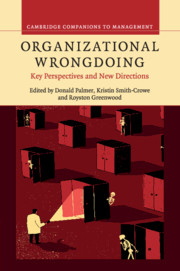Book contents
- Frontmatter
- Contents
- List of figures
- List of tables
- List of contributors
- Foreword
- 1 The imbalances and limitations of theory and research on organizational wrongdoing
- 2 On taking the theoretical substance of outcomes seriously: a meta-conversation
- 3 Wrong paths to right: defining morality with or without a clear red line
- 4 From market enablers to market participants: redefining organizational and political-legal arrangements and opportunities for financial wrongdoing,1930s–2000
- 5 Wrongdoing and market development: an examination of the distinct roles of trust and distrust
- 6 Bad apples, bad barrels and bad cellars: a “boundaries” perspective on professional misconduct
- 7 S/he blinded me with science: the sociology of scientific misconduct
- 8 Social networks and organizational wrongdoing in context
- 9 Falling stars: celebrity, infamy, and the fall from (and return to) grace
- 10 Compensation and employee misconduct: the inseparability of productive and counterproductive behavior in firms
- 11 Beware of organizational saints: how a moral self-concept may foster immoral behavior
- 12 “Is it me? Or is it me?” The role of coactivated multiple identities and identifications in promoting or discouraging workplace crimes
- 13 Consequences of organizational misconduct: too much and too little punishment
- 14 Who bears the brunt? A review and research agenda for the consequences of organizational wrongdoing for individuals
- 15 Organizational wrongdoing and media bias
- 16 Ethical learning: releasing the moral unicorn
- Index
- References
7 - S/he blinded me with science: the sociology of scientific misconduct
Published online by Cambridge University Press: 05 July 2016
- Frontmatter
- Contents
- List of figures
- List of tables
- List of contributors
- Foreword
- 1 The imbalances and limitations of theory and research on organizational wrongdoing
- 2 On taking the theoretical substance of outcomes seriously: a meta-conversation
- 3 Wrong paths to right: defining morality with or without a clear red line
- 4 From market enablers to market participants: redefining organizational and political-legal arrangements and opportunities for financial wrongdoing,1930s–2000
- 5 Wrongdoing and market development: an examination of the distinct roles of trust and distrust
- 6 Bad apples, bad barrels and bad cellars: a “boundaries” perspective on professional misconduct
- 7 S/he blinded me with science: the sociology of scientific misconduct
- 8 Social networks and organizational wrongdoing in context
- 9 Falling stars: celebrity, infamy, and the fall from (and return to) grace
- 10 Compensation and employee misconduct: the inseparability of productive and counterproductive behavior in firms
- 11 Beware of organizational saints: how a moral self-concept may foster immoral behavior
- 12 “Is it me? Or is it me?” The role of coactivated multiple identities and identifications in promoting or discouraging workplace crimes
- 13 Consequences of organizational misconduct: too much and too little punishment
- 14 Who bears the brunt? A review and research agenda for the consequences of organizational wrongdoing for individuals
- 15 Organizational wrongdoing and media bias
- 16 Ethical learning: releasing the moral unicorn
- Index
- References
Summary
Recent years have witnessed increasing attention to misconduct and fraud in academic scholarship, particularly in scientific research. As shown in Figure 7.1, retraction rates among publications in scientific journals have increased astronomically – roughly ten-fold since 2000 (Steen, Casadevall, and Fang 2013; Van Noorden 2011).
That trend seems both stunning and perplexing if one considers the typical narrative provided to explain these events: Some individual scientist, succumbing to avarice, insecurity, or incompetence, whether knowingly or unwittingly, publishes erroneous findings. His peers nevertheless discover this deviance and ensure its correction. In essence, errant research, whether intentional or not, comes from a set of “bad apples.” But given the slow rate at which turnover occurs in the population of scientists, this explanation would appear to have little purchase in explaining the dramatic rise in retractions over the past decade. Other putative causes – such as the increased competition for scarce funding and positions and improvements in the ability to detect errors and fraud – have also changed far more gradually and slowly than the rate of retractions. Therefore, they would appear incomplete, at best, as explanations for this trend.
However, this trend does closely resemble the rate at which the popular press has called attention to misconduct and fraud in another setting: the corporate world. Figure 7.2 documents that trend, with a pattern and magnitude of increase strongly resembling Figure 7.1, save for two anomalous years: 1996 (fallout from the price-fixing scandal involving Archer Daniels Midland) and 2002 (notable for the collapse of Enron and Andersen).
Far from being a coincidence, we suspect that the correspondence between these plots reflects the fact that both stem from common causes of organizational wrongdoing, a point to which we return in our conclusion. Below, we draw on our ongoing work examining misconduct in scientific research to identify factors at the interpersonal, organizational, and institutional levels that encourage and inhibit organizational wrongdoing.
Beyond simply connecting these trends, we also argue that the study of scientific misconduct can enrich our understanding of organizational wrongdoing in other contexts. Scientific research provides an unusually fruitful domain within which to broaden and deepen this understanding for at least two reasons. First, relative to the corporate world and many voluntary associations, academic science takes place within relatively “weak” organizations, with highly autonomous and mobile actors.
- Type
- Chapter
- Information
- Organizational WrongdoingKey Perspectives and New Directions, pp. 176 - 202Publisher: Cambridge University PressPrint publication year: 2016
References
- 2
- Cited by



